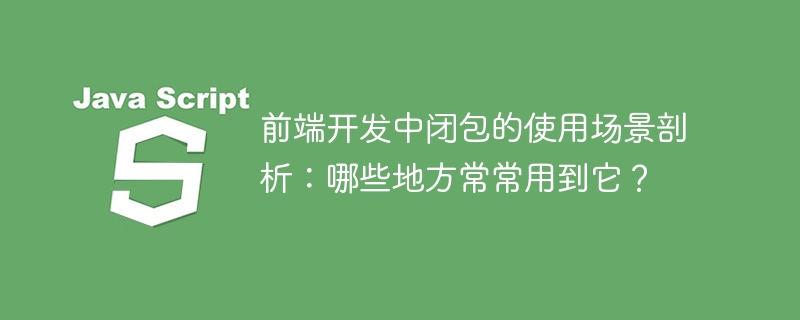

Analysis of usage scenarios of closures in front-end development: Where are they often used?
As a front-end developer, it is very important to understand the usage scenarios of closures. Closures are a powerful concept in JavaScript that can help us solve many problems. This article will explore scenarios where closures are commonly used in front-end development and give specific code examples.
In front-end development, it is often necessary to add event handlers for DOM elements. Closures can help us retain state within a certain scope in event handlers. For example, consider the following code:
function addButtonHandlers() {
var buttons = document.getElementsByTagName("button");
for (var i = 0; i < buttons.length; i++) {
var button = buttons[i];
button.addEventListener("click", createClickHandler(i));
}
}
function createClickHandler(index) {
return function() {
console.log(index);
};
} In the above code, the createClickHandler function returns a new function that acts as an event handler. This new function is a closure that references the index variable in the outer scope. In this way, each button's click event will correctly display its corresponding index.
JavaScript does not natively support the concept of private variables. However, closures provide a way to simulate private variables. By creating a local variable inside a function and returning it as a closure, we can implement a variable that is only accessible within the scope of that function. For example:
function createCounter() {
var count = 0;
return {
increment: function() {
count++;
},
decrement: function() {
count--;
},
getCount: function() {
return count;
}
};
}
var counter = createCounter();
counter.increment();
console.log(counter.getCount()); // 输出 1In the above code, the createCounter function returns an object containing three methods. These methods can access and operate the count variable inside the function, but the variable cannot be directly accessed from the outside.
Closures are also often used in modular development, especially in environments without a module system. By using closures and immediately executed function expressions (IIFE), we can create a private namespace, define private variables and methods in it, and return the public interface. For example:
var MyModule = (function() {
var privateVariable = "Private";
var publicVariable = "Public";
function privateMethod() {
console.log("Private method");
}
function publicMethod() {
console.log("Public method");
}
return {
publicVariable: publicVariable,
publicMethod: publicMethod
};
})();
console.log(MyModule.publicVariable); // 输出 "Public"
MyModule.publicMethod(); // 输出 "Public method"In the above code, the MyModule object contains a public variable and a public method. Inside the immediate execution function, we can define private variables and private methods, and return the methods and variables that need to be public.
When using loops to iterate, due to JavaScript's function scope and variable promotion mechanism, you often encounter problems with variable sharing. Closures can help us solve this problem. For example, consider the following example:
for (var i = 0; i < 5; i++) {
setTimeout(function() {
console.log(i);
}, 1000);
}In the above code, you want to output a number every second. However, due to the nature of closures, when setTimeout is executed, all callback functions share the i variable in the same scope. Therefore, the output result will be 5 5s instead of 0, 1, 2, 3, and 4. In order to solve this problem, you can use a closure to store the i variable value for each loop iteration:
for (var i = 0; i < 5; i++) {
(function(i) {
setTimeout(function() {
console.log(i);
}, 1000);
})(i);
}By passing in the i in the immediate execution function value and creates a closure so that each callback function can correctly access the corresponding i value.
In front-end development, closure is a very powerful and commonly used concept. Understanding the usage scenarios of closures can help us solve problems better and improve the quality and efficiency of code. I hope this article has brought you a deeper understanding of closures and helped you with your front-end development work.
The above is the detailed content of How to use closures for analysis and analysis in common front-end development scenarios. For more information, please follow other related articles on the PHP Chinese website!